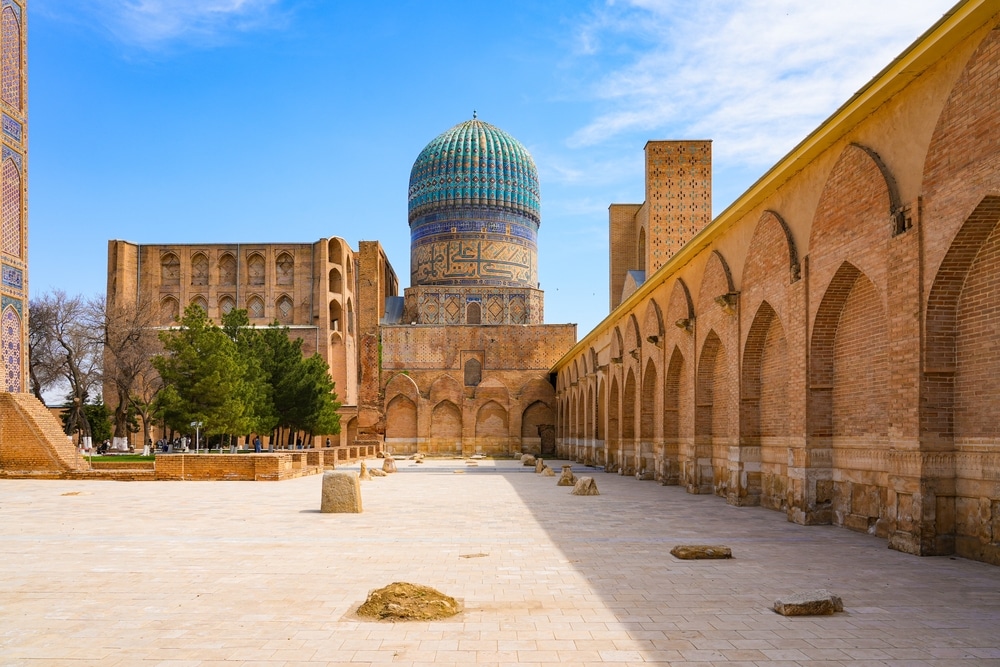For more than fifteen centuries, the Silk Road was the world’s economic highway for everything related to trade and diplomacy, and no other place was as central to this network as Uzbekistan. The money, creativity, and culture that poured into this trade route left behind some of the country’s most breathtaking sights, which remain very well preserved to this day. In this article, we will introduce you to the main attractions of the Silk Road that you can marvel at in Uzbekistan and that you should definitely visit during your visit to Central Asia.
The trendiest sights in Samarkand
The Registan
If you have the time or budget to visit just one Uzbekistan destination, you won’t regret visiting the Registan. The central square in Samarkand offers everything that honors the Silk Road. It is home to titular but still magnificent madrasahs, all covered in mosaic tiles and glowing in the colors of gold, indigo, lapis lazuli and azure at dusk and dawn. These Islamic schools from the heyday of the Silk Road were built between 1400 and 1600 during the Timurid dynasty . The Registan was a junction in the heart of the trade route. Students came from far and wide to learn religion and mathematics. Some say that early mathematicians and scholars in this region may have played a role in the development of a game that later became chess. In fact, the trade, activities, cultures and objects exchanged in this square have been the inspiration for many historical books, films and virtual games such as Silk Road, Silk Road Riches and other titles that you can find on this website .
The Bibi-Khanym Mosque
The Bibi Khanym Mosque was built around 1300 by Timur with the proceeds from the invasion of India. The mosque, tiled with blue mosaics, is still one of the largest in Central Asia but also in the world. It has a beautiful dome that is a dizzying 42 meters high, while the Pishtaq is only slightly lower than it at 38 meters. We suspect that some faithful pilgrims made a stop here to pray on their trading journeys along the Silk Road. If you are more interested in avant-garde Islamic architecture, then this mosque will suit your taste. Be sure to check out the large marble Koran stand in the courtyard. It is located northeast of Registand.
Shah-i-Zinda
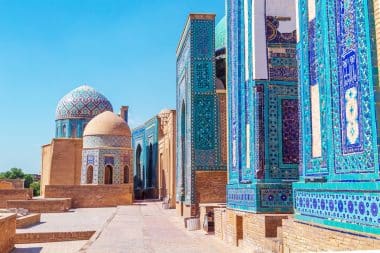
Think of Shah-i-Zinda as a boulevard of mausoleums. In this street you will find the most stunning and moving Islamic architecture along the Silk Road. Here, East Asian, Central Asian and Persian architecture and styles mix like nowhere else, especially when it comes to design and tile work.
Gur-e-Amir
Gur-e-Amir is the final resting place of the famous Timur. He was also called Tamerlane and was the Amir (Emir) of the Timurid Empire, which stretched over much of Central Asia, Iran and present-day Afghanistan. One cannot talk about the history and enormous size of the Silk Road without mentioning the influence of the Ulugbek Empire. Gur-e-Amir offers everything the heart of every fan of the Silk Road desires. The gold-painted mausoleum features some of the most glittering mosaics and gilded domes. The best way to visit the attraction is as part of a guided tour, because there is a lot to see in and around the mausoleum.
Places to visit in Khiva
Ichon Qala, an open-air mausoleum
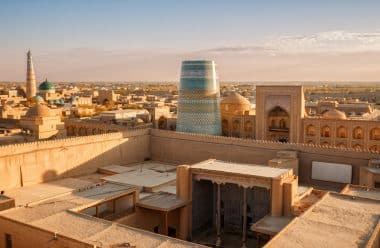
Legend has it that Khiva was founded by Noah’s son. This may be far-fetched, but there is some truth in every legend. The entire walled Old City is a reminder of the power and economic performance of trade on the Silk Road. Expect an abundance of Islamic architecture and Asian history.
Kalta Minor Minaret
Construction of this blue-tiled minaret began in 1851 and was never completed due to the ruler’s early death. It still stands as a symbol of Khiva’s rich architectural ambitions. Twenty-nine meters high and 14 meters wide, the minaret is an impressive sight with its turquoise blue tiles. If you’re here in the evening, check out the food scene and pick up some memorabilia from the souvenir stalls nearby.
The best of the Silk Road city of Bukhara
The Ark, a 5th-century fortress in Bukhara
This ancient fortress in the heart of Bukhara was once the residence of the local emirs. Walking through the walls is like stepping back in time and offering insights into the lives of those who made the Silk Road their home.
The Kalon Mosque and Minaret in Bukhara
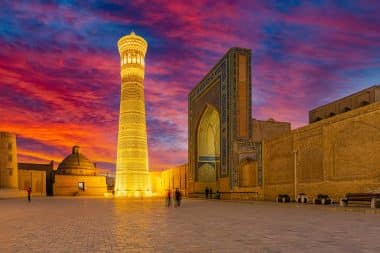
It is said that this towering minaret was the only structure that Genghis Khan did not destroy when he and his warriors swept through Central Asia. The complex is a spectacular example of Islamic architecture, with fine tiles and a minaret built of clay that has survived the centuries until now.
Char Minar
This small but iconic structure shows influences from Indian and South Asian architecture – a vivid example of how artistic styles were able to develop along the Silk Road.
The bazaars in the Silk Road
The interconnected domed bazaars of Bukhara will take you right back to the time of the region’s heyday. The Taki-Sarrafon (Money Changer Bazaar), the Taki-Telpak Furushon (Cap Makers’ Bazaar) and the Taki-Zargaron (Jewelers’ Bazaar) offer a glimpse into the commercial heart of the old trade routes.
Uzbekistan outside major cities
The Khan Palace in Kokand
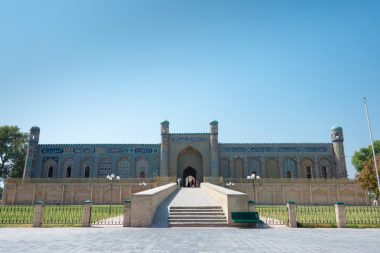
Located in the eastern Fergana Valley, Khan Palace has 114 ornately decorated rooms and offers an impressive insight into the region’s royal history.
The Termez Archaeological Museum
Located in the southernmost city of Uzbekistan, this museum showcases the incredible cultural diversity of the Silk Road – from Greek-influenced statues to Buddhist icons and chess pieces made of Bactrian ivory.
Tips for an optimal trip along the Silk Roads in Uzbekistan
Uzbekistan is the most touristic country in Central Asia, but it is still opening up further. It’s worth doing the paperwork well in advance of the trip. Speaking of traveling, the best time to travel to Uzbekistan is either September to October or April to May. It goes without saying that you should pack light clothing and sturdy but comfortable shoes. Learn some Uzbek expressions and always dress modestly and adapted to the situation.


